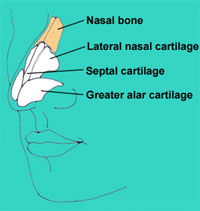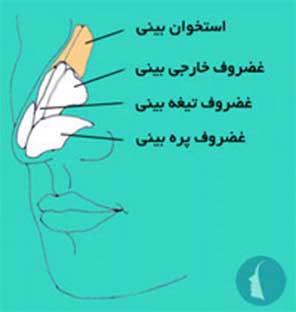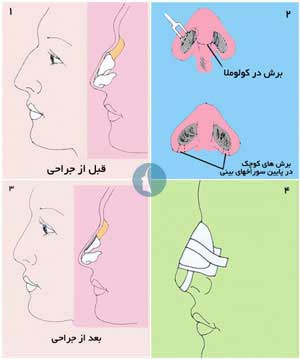Rhinoplasty (Nose Job)
One of the most common plastic surgery is rhinoplasty or cosmetic nose surgery. In this operation, the surgeon can change the nose by considering its conditions in different ways, including changing the size, shape, and angle; in addition the surgeon can correct other problems such as obstruction of breathing path or deviated septum.
Anatomy of the Nose
Anatomy of the nose (of course the part that is related to nose surgery) are as follows:
- The upper part of the nose is called the nasal bridge. Dip of the nose towards the tip of the nose, is called the back of the nose (dorsum).
- Nostrils are between the nose and upper lip, and a strip of skin which is located between holes is called cullomella.
- The upper part of the back of the nose is formed of nasal bones while the lower part of the nose is formed of cartilage.
- Cartilage septum is placed in the midline and on both sides of it the lateral nasal cartilage is located. Blades on each side of the nose is cartilage that covers and protects them from the nostrils to that are located on each side of the lateral nasal cartilage is located. There are ala on each side of cartilage that covers nostrils and protects them.

Indications:
- Cosmetic nose surgery (rhinoplasty) is optional and usually there is no compulsion or necessity in it.
- Most applicants of surgery are under 30 years.
- In some cases, breathing problems will force people to do the surgery.
- A person does not like the appearance of his nose; however he does not have an unrealistic desire for perfection.
Contraindications:
- There is usually no specific impediment for cosmetic nose surgery unless a person is under particular medical conditions such as severe heart disease.
- However there are some considerations:
1. For the nose surgery, teens should wait until their growing age is finished.
2. Blood coagulation problems may cause bleeding. Aspirin may affect the blood coagulation process, so if you take aspirin, be sure to inform your surgeon.
3. The individual should avoid smoking at least, two to four weeks before nose surgery, because nicotine may delay the healing process.
4. The body of person may make keloid (the remaining of scars are called keloid)
5. Individuals need to be realistic in their expectations of the nose surgery, especially adolescents and their parents. Nose Surgery can improve the appearance and thus increases confidence but not in any way makes a new person or a different face.
6. Past nose surgery may cause some problems. If you have already done nose surgery and if you want to redo it, you must explain it to your surgeon.
Surgical Procedure:
- Cosmetic nose surgery (rhinoplasty) may be done in a hospital or clinic or limited surgical center under general anesthesia (asleep) or local anesthesia (awake) with sedation.
- Briefly nose surgery, involves lifting the nose skin from the bone and cartilage underneath the skin, and reshaping the bone and cartilage, and put the skin in its own place and hence the formation of skin with the reshaped bone and cartilage
- Some surgeons may make incisions inside the nostrils which it referred as closed rhinoplasty, however some may in addition to these holes, create a hole in strip of skin between the two holes (cullomella) to lift the entire skin of the nose and this approach is called open rhinoplasty. (Figure 2)
- When the skin was removed from the bone and cartilage, the hump in the back of the nose becomes flat by cutting nasal bones and shortening septum. (Figure 3)
- Big nostrils become small by removing small pieces of base holes skin on each side (Figure 2)
- In the process of changing the shape of the nose according to the needs and the shape of the nose, we may change the shape of the nasal tip and the angle between the nose and upper lip.
- After completion of surgery, to maintain the shape of newly operated nose, a nasal splint is placed on the back of nose. (Figure 4)
- Special tampons are placed inside the nostrils to support cartilaginous septum in the middle of the nose, after the surgery.

 فارسی
فارسی  العربية
العربية  Русский
Русский  Kurdish
Kurdish 

